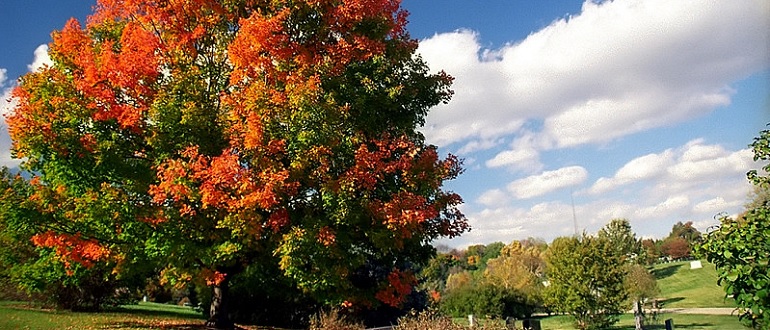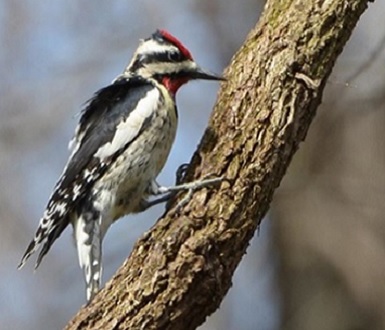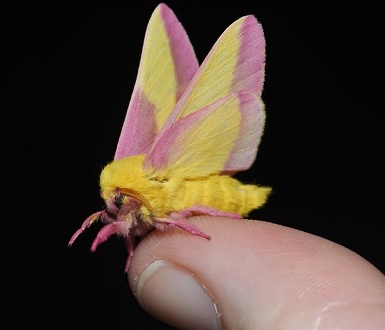Sugar Maple (Acer saccharum) – photo: David Ohmer CC-BY-2.0
GET TO KNOW
The American Sugar Maple
Once again, the beautiful fall color season is upon us. The sugar maple (Acer saccharum), in glorious shades of gold and orange, is always a star of the show.
How wonderful that this lovely tree is a Michigan native. In fact, in the days before human settlement – sugar maples were one of the most common trees in southeast Michigan. Majestic sugar maples, red maples, and American beech trees grew together as dense beech/ maple forests.
FUN FACT: The delicious, sweet flavor of the sugar maple’s sap is well known and appreciated. Less well known is the culinary secret that sugar maple sap can be used to make a flavorful vinegar. Historically, members of the Ojibwa tribe made a sour vinegar from maple sap for preserving meats. They then combined both the maple vinegar and maple sugar to create sweet and sour dishes.
Two hundred years ago, those shaded wonderlands were one of the dominant natural communities found in the Rouge watershed. Back then, beech-maple forests provided thousands of acres of woodland habitat for wildlife. Unfortunately, only a few small bits of those old-growth forests remain today.
In addition to their beauty, sugar maples offer a bounty of gifts. There are the obvious delights of maple sugar and maple syrup. As noted in the Fun Fact, native Americans made sour maple vinegar from the sap and used maple bark for teas and dyes. Additionally, maple hardwood has long been considered one of the finest woods for furniture and cabinet making.
For wildlife, the gifts of the sugar maple are even more numerous. This species’ magnificent crown provides sturdy branches for bird and squirrel nests and cooling shade for all who rest below. Rough maple bark provides excellent insect habitat and prime foraging grounds for insect eating birds. In the springtime, maple flowers (quite small and inconspicuous), buds and seeds are diet staples for songbirds, grouse, wild turkeys, squirrels, chipmunks, and many other foraging animals.
The tree’s rich sap flows as early as late February and offers sweet nutrition. Maple sap is the preferred drink of the handsome yellow-bellied sapsucker. These small woodpeckers may often be found diligently pecking at sugar maples where they enjoy a tasty sip of maple sap along with a main course of their favorite bugs.
And last, but certainly not least, sugar maples serve as a larval host for a great many insects including the beautiful rosy maple moth. There are even a few “generalist” butterflies, such as the Eastern tiger swallowtail, whose caterpillars may find a home on sugar maples. (Generalist butterflies are those whose caterpillars are not tied to one specific plant so the females may lay eggs on several different plants.) Though it is an often forgotten element for pollinator gardens, many trees – including the sugar maple – serve as important larval hosts for a number of butterfly and moth species.
PLANT SPECIFICATIONS
Sugar maples are large trees that reach up to 75 feet tall and have huge, oval shaped crowns that spread 50 feet in diameter. They are among the strongest and finest of hardwoods. Yet, in some ways, they are also delicate trees.
Sugar maples are native to the temperate zones and do not do well in severe temperature extremes. Their rather shallow root systems can suffer from freezing during extreme cold if there is not a protective layer of snow cover. Conversely, global warming is slowly pushing up (north) the southern margins of their native zone. Sugar maples also do not do well in either dry or swampy areas; but rather, they require consistently moist and well-drained soil to thrive. And, most importantly, sugar maples are very intolerant of salt and chemical pollutants. Consequently, these trees suffer from exposure to road salts, lawn chemicals, and acid rain.
Unfortunately, the combined effect of such risk factors has led to a decline in the health and longevity of these beautiful trees. In today’s suburban landscapes, sugar maples are best suited to large, lowland parks where they may be safely located away from roads, parking lots, and lawn sprayers – and where they have room to shine in all their autumn glory.
TAKE ACTION
An abundance and variety of proper native plants are essential to the health of every watershed. When planting new or replacement trees, select a true Michigan native species. (Avoid invasive species such as Tree of Heaven, Norway maple, and Autumn olive.) It is always important to match a tree’s size and growing condition requirements to a potential planting site.
FOTR started “Rouge Rescue” in 1986 to physically remove trash from the river. This initial rescue effort has continued each year and has expanded to include planned invasive plant removals and restorative plantings of native trees, shrubs, grasses, and wildflowers. You can help create a healthy watershed by replacing invasive species with such beautiful native species as the sugar maple.
Categories
-
News & EventsLearn more about upcoming FOTR events and projects


